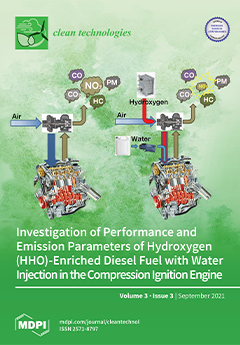The development of engine technologies and research on combustion processes are focused on finding new generation CI engines with simple control of the combustion process while efficiently maintaining desirable engine performance and meeting emission regulations. This comprehensive study on the relatively low hydrogen energy fraction (0.65–1.80%), supplied by onboard water electrolysers and on water injection, was performed on the performance and emission parameters of the CI engine. The article presents results of both experiment and simulation about the effect of hydroxygen and water injection on the combustion process, auto-ignition delay, combustion intensity, the temperature of the mixture and engine performance at
BMEP of 0.2 MPa, 0.4 MPa, 0.6 MPa, and 0.8 MPa at a speed of 1900 rpm. For the first part, the test engine operated with diesel fuel with 3.5 L/min of hydroxygen gas supplied with an external mixture formation. The HHO has an effect on the combustion process at all range of
BMEP. A decrease in
BTE and increase in
BSFC were noticed during tests. The peak pressure and the rate of heat release decreased, but the NO
x decreased as well. The second part of experiment was performed with the injection of a substantial amount of water, 8.4–17.4 kg/h (140–290 cm
3/min), and the same amount of hydroxygen. The injection of water further decreased the NO
x; therefore, HHO and WI can be used to meet emission regulations. A simulation of the combustion process was carried out with the AVL BOOST sub-program BURN. The AVL BOOST simulation provided a detailed view of the in-cylinder pressure, pressure-rise, combustion intensity shape parameter and SOC.
Full article





